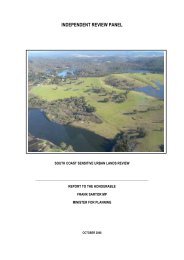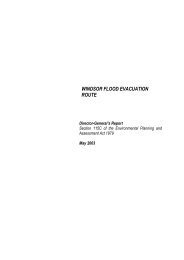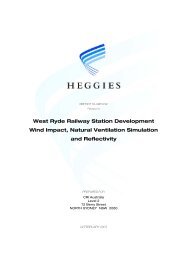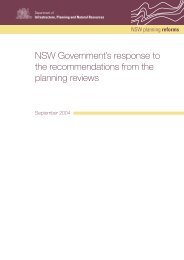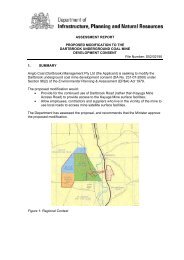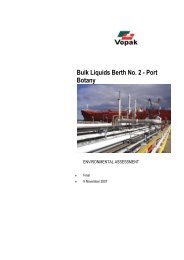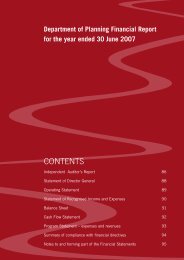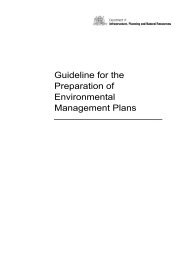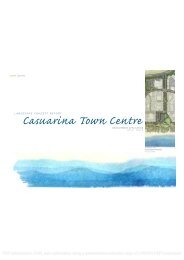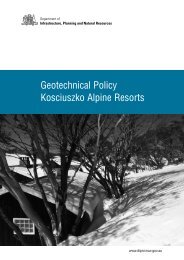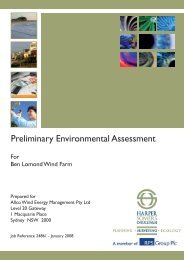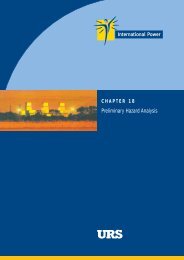Pacific Pines Estate, Lennox Head - Department of Planning
Pacific Pines Estate, Lennox Head - Department of Planning
Pacific Pines Estate, Lennox Head - Department of Planning
Create successful ePaper yourself
Turn your PDF publications into a flip-book with our unique Google optimized e-Paper software.
approximately 6.7ha (78%) <strong>of</strong> degraded wetland vegetation, which currently supports patches <strong>of</strong> Squarestemmed<br />
spike-rush at very low densities (i.e. less than 5% cover). The clearance <strong>of</strong> this vegetation will<br />
be compensated for by:<br />
• on-site retention and enhancement <strong>of</strong> 1.8ha (or 22%) <strong>of</strong> retained wetland vegetation within the<br />
Conservation Zone network; and<br />
• the establishment <strong>of</strong> <strong>of</strong>f-site reserves that have a dual function in increasing the connectivity<br />
values <strong>of</strong> the entire Conservation Zone/Green Space network, as well as providing <strong>of</strong>fsets for the<br />
displacement <strong>of</strong> Square-stemmed spike-rush habitat within the site.<br />
‘Alteration to natural flow regimes’ can occur through reducing or increasing flows, altering seasonality <strong>of</strong><br />
flows, changing the frequency, duration, magnitude, timing, predictability and variability <strong>of</strong> flow events,<br />
altering surface and subsurface water levels and changing the rate <strong>of</strong> rise or fall <strong>of</strong> water levels (DEC<br />
2004).<br />
The hydrology <strong>of</strong> wetland habitat retained within the development layout area will not be significantly<br />
altered from the existing situation. Any changes will involve increased short term flood depths<br />
upstream <strong>of</strong> the two proposed constructed weirs and slightly increased flood flow velocities over these<br />
weirs in some storm events. These weirs will only function during storm events, causing water to be<br />
stored at a greater depth than is currently the case. Water flow velocities remain largely unchanged<br />
because weirs have low flow bypasses to mimic existing stream flow outside <strong>of</strong> storm events. During<br />
flood events, the detention effects provide the same peak flow discharges as the existing situation at<br />
slightly increased velocities. Therefore, the impact on retained wetland is that there will be a greater<br />
depth <strong>of</strong> water in the area during a storm event. It is not envisaged that an increase in the depth <strong>of</strong><br />
water during a storm event will have an adverse impact on retained populations <strong>of</strong> Square-stemmed<br />
spike-rush<br />
Conclusion<br />
Given the above facts and circumstances, the proposed development will not have a significant impact<br />
on the ongoing viability <strong>of</strong> Square-stemmed spike-rush in the locality as:<br />
• 22% <strong>of</strong> the potential Square-stemmed spike-rush habitat located on the site will be retained and<br />
rehabilitated with the Conservation Zone/Green Space network;<br />
• appropriate <strong>of</strong>f-site reserves have been identified and negotiations are in place to secure this land<br />
biodiversity conservation purposes;<br />
• proposed on-site mitigation measures will enhance retained populations within the development<br />
layout;<br />
• the proposed Conservation Zone/Green Space network will provide connectivity between the<br />
known Square-stemmed spike-rush population within the site and areas <strong>of</strong> suitable habitat within<br />
and adjacent to the site; and<br />
• contributions will be made through the implementation <strong>of</strong> a Square-stemmed spike-rush<br />
Management Strategy, to a number <strong>of</strong> the Priority Actions identified by DECC for the recovery <strong>of</strong><br />
Square-stemmed spike-rush.<br />
References<br />
Bell, D., Campbell, M. L. and Bruhl, J. J. (2000) Population dynamics and disturbance regime <strong>of</strong> the<br />
threatened plant Square-stemmed spike-rush Eleocharis tetraquetra Nees. Technical Report to the<br />
NSW National Parks and Wildlife Service. University <strong>of</strong> New England, Armidale NSW.<br />
<strong>Department</strong> <strong>of</strong> Environment and Climate Change (last updated 1 st September 2005). Square-stemmed<br />
Spike-rush (Eleocharis tetraquetra) Endangered Species Determination.<br />
http://www.threatenedspecies.environment.nsw.gov.au/tspr<strong>of</strong>ile/pr<strong>of</strong>ile.aspx?id=10265<br />
Accessed 11 th June 2008<br />
Petrac 16 June 2008<br />
I:\7296-21\wp\7 Part Test\7 Part Test_Eleocharis.doc Page 6



